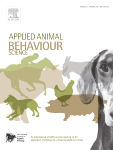Document type : Scientific article published in Applied Animal Behaviour Science
Authors: Silja Griss, Stefanie Riemer, Charlotte Warembour, Filipe Maximiano Sousa, Ewaldus Wera, Monica Berger-Gonzalez, Danilo Alvarez, Petrus Malo Bulu, Alexis López Hernández, Pablo Roquel, Salome Dürr
Although free-ranging domestic dogs (FRDDs) make up the majority of the global dog population, we know little about many aspects of their habitat-specific ecology. Activity budgets for these dogs can also inform management decisions for domestic dogs living with humans. We collected data on the activity patterns of domestic dogs from Guatemala (n = 58) and Indonesia (n = 37), as well as farm dogs (n = 11) and pet dogs (n = 20) in Switzerland. A common feature between FRDDs in both countries and the Swiss farm dogs was the fact that, although they had owners, they spent most or all of the day outdoors without being shut in. By contrast, the activity of pet dogs is largely controlled by their owners. This transcontinental study therefore allowed us to distinguish between environmental influences on dog activity and the effects of different levels of human control. Dogs were fitted with FitBark activity trackers, which measure 3D acceleration, for 2.4 to 7 days. The activity of each dog was defined as the sum of BarkPoints (a continuous activity measure recorded by the FitBark tracker), calculated for each hour of the 24-hour cycle. The proportion of resting time, "moderate" and "high" activity (defined by fixed BarkPoints thresholds) over 24 hours was calculated for each dog. The activity patterns of all (at least partly) free-moving dogs, i.e., Guatemalan and Indonesian domestic dogs and Swiss farm dogs, showed two peaks in the 24-hour period, one between 5 am and 7 am and the other, less pronounced, between 4 pm and 7 pm. This bimodal activity pattern, which has also been observed in other canine species, was detected in only 45% of pet dogs. The latter's activity is more dependent on the daily habits of their owners and its peak is mainly in the middle of the day, at different times from one day to the next. Swiss farm dogs spent significantly more time resting and less time in "moderate" activity than pet dogs. However, the companion dogs had a significantly greater frequency of very high activity than any other dog group and compensated for this with longer rest periods. Activity decreased significantly with age, neutering and increased body condition scores, while sex had no significant influence on activity. This study thus identified similarities, but also differences, between the activity patterns of FRDDs and companion dogs. Although the overall activity levels of the companion dog sample came within the range of those observed in the less-controlled FRDDs, it would be interesting to investigate the potential benefits of a more structured daily program for companion dogs in future studies.
Preview: Although free-roaming domestic dogs (FRDD) constitute the majority of the dog population worldwide, many aspects of their ecology across habitats are little known. Activity budgets by these dogs may also inform management decisions for domestic dogs in human hands. Here we collected data on the activity patterns of owned FRDD from Guatemala (n = 58) and Indonesia (n = 37), and of farm dogs (n = 11) and family dogs (n = 20) in Switzerland. The FRDD from the two countries and the Swiss farm dogs shared the similarity that although they had owners, they spent most or all of the day outside without confinement. Conversely, activity in family dogs is largely controlled by their owners. This cross-continental study thus allowed us to tease apart environmental effects on dogs' activity from effects due to different levels of control by humans. Dogs were collared with FitBark activity trackers, which measure 3D acceleration, for 2.4-7 days. Activity for each dog was defined as the sum of BarkPoints (a continuous activity metric recorded by the FitBark tracker), calculated for each hour in the 24-hour cycle. The proportion of time resting, in 'moderate' and 'high' activity (defined by fixed thresholds of BarkPoints) over 24 h was calculated for each dog. The activity patterns of all dogs that (partly) roam freely, i.e. owned FRDD in Guatemala and Indonesia and Swiss farm dogs, showed two peaks over 24 h during 5:00-7:00 h and, less pronounced, 16:00-19:00 h. Such a bimodal activity pattern, which is also observed in other canine species, could only be detected in 45% of the family dogs. Their activity is more dependent on the owners' daily routines and predominantly showed one high mid-day peak that often changes from day to day. Swiss dogs spent significantly more time resting and less time with 'moderate' activity than the owned FRDD. However, family dogs were significantly more often highly active than all other dog groups and compensated with longer resting periods. Activity decreased significantly with age, neutering and increased body condition score, whereas sex did not have any significant influence on activity. Within this study, similarities, but also differences of the activity pattern between owned FRDD and pet dogs could be revealed. Although overall activity levels of the pet dog sample fall in the range of those observed in the less controlled FRDD, it would be of interest to investigate the potential benefit of a more structured daily schedule on pet dogs in future studies.






